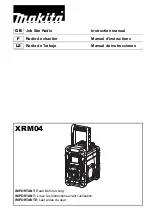
4.1 General cabling guidance
Cable types and length
It is important to use cables of the appropriate type
and length
• Unless otherwise stated use only standard cables
of the correct type, supplied by Raymarine.
• Ensure that any non-Raymarine cables are of the
correct quality and gauge. For example, longer
power cable runs may require larger wire gauges
to minimize voltage drop along the run.
Routing cables
Cables must be routed correctly, to maximize
performance and prolong cable life.
• Do NOT bend cables excessively. Wherever
possible, ensure a minimum bend diameter of 200
mm (8 in) / minimum bend radius of 100 mm (4 in).
100 mm (4 in)
200 mm (8 in)
• Protect all cables from physical damage and
exposure to heat. Use trunking or conduit where
possible. Do NOT run cables through bilges or
doorways, or close to moving or hot objects.
• Secure cables in place using tie-wraps or lacing
twine. Coil any extra cable and tie it out of the way.
• Where a cable passes through an exposed
bulkhead or deckhead, use a suitable watertight
feed-through.
• Do NOT run cables near to engines or fluorescent
lights.
Always route data cables as far away as possible
from:
• other equipment and cables,
• high current carrying ac and dc power lines,
• antennae.
Strain relief
Ensure adequate strain relief is provided. Protect
connectors from strain and ensure they will not pull
out under extreme sea conditions.
Circuit isolation
Appropriate circuit isolation is required for
installations using both AC and DC current:
• Always use isolating transformers or a separate
power-inverter to run PC’s, processors, displays
and other sensitive electronic instruments or
devices.
• Always use an isolating transformer with Weather
FAX audio cables.
• Always use an isolated power supply when using
a 3rd party audio amplifier.
• Always use an RS232/NMEA converter with
optical isolation on the signal lines.
• Always make sure that PC’s or other sensitive
electronic devices have a dedicated power circuit.
Cable shielding
Ensure that all data cables are properly shielded
that the cable shielding is intact (e.g. hasn’t been
scraped off by being squeezed through a tight area).
Blanking plugs
Connectors not in use should be protected using
blanking plugs.
Connectors on the product or accompanying cables,
that are not in use (not connected), should be
covered using blanking plugs if supplied.
28
Ray50 / Ray60 / Ray70
Содержание RAY50
Страница 2: ......
Страница 4: ......
Страница 14: ...14 Ray50 Ray60 Ray70...
Страница 26: ...26 Ray50 Ray60 Ray70...
Страница 74: ...74 Ray50 Ray60 Ray70...
Страница 78: ...78 Ray50 Ray60 Ray70...
Страница 82: ...82 Ray50 Ray60 Ray70...
Страница 92: ...92 Ray50 Ray60 Ray70...
Страница 98: ...98 Ray50 Ray60 Ray70...
Страница 102: ...102 Ray50 Ray60 Ray70...
Страница 115: ......
Страница 116: ...www raymarine com...
















































